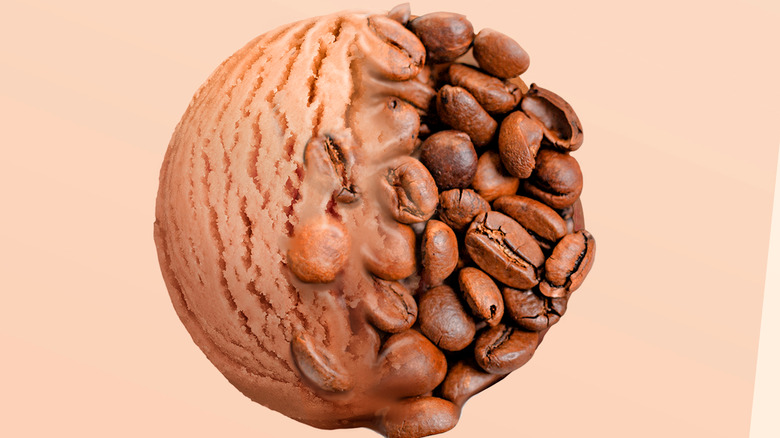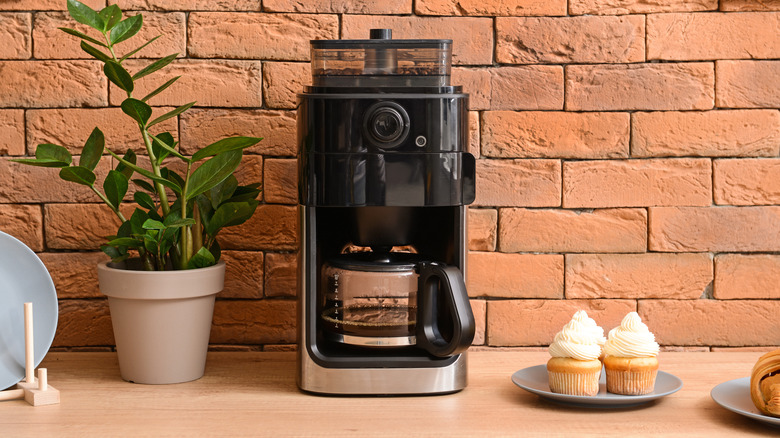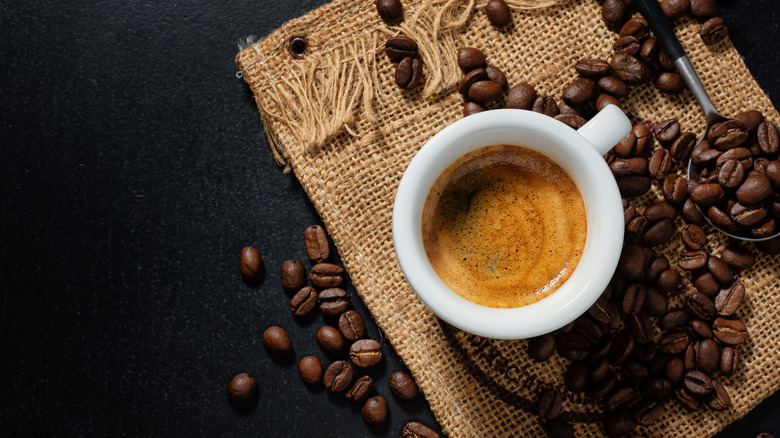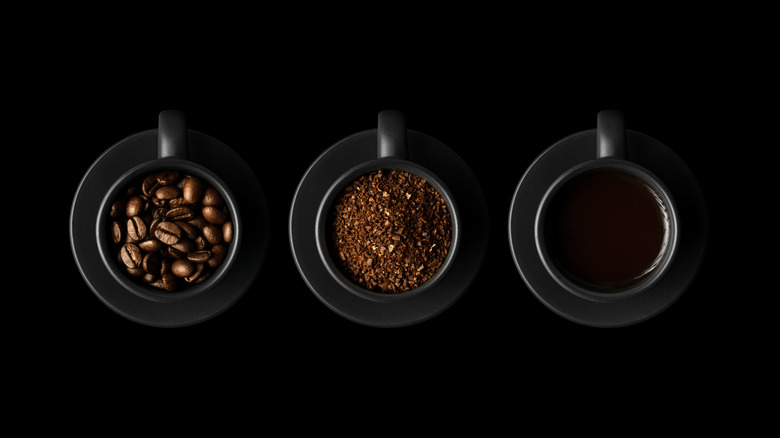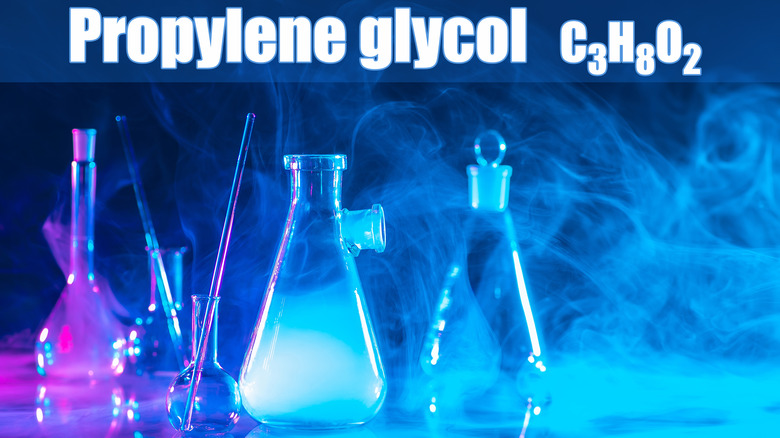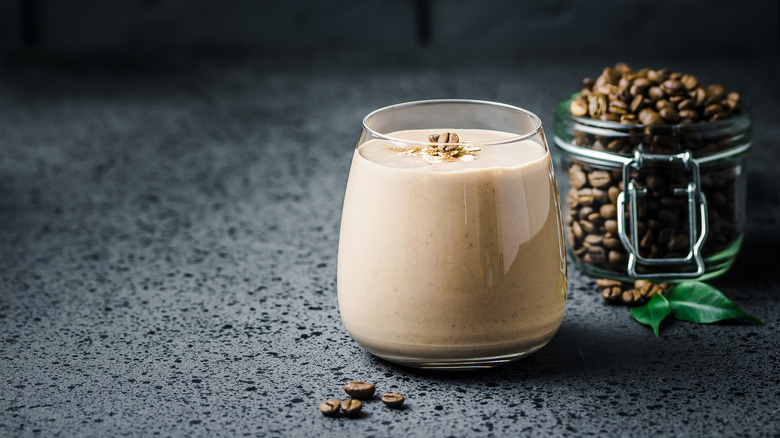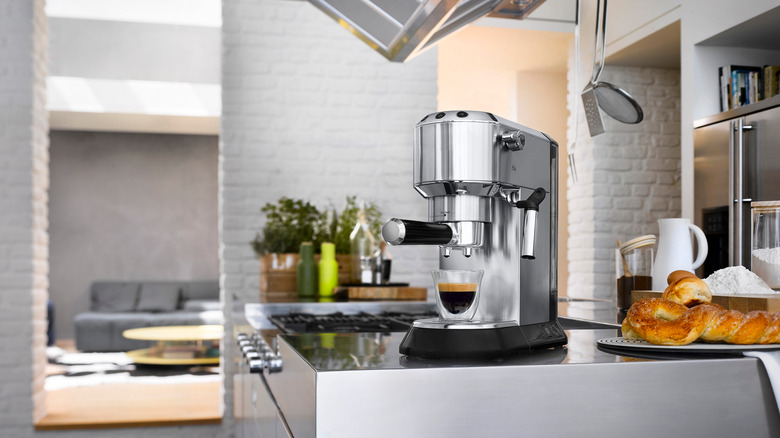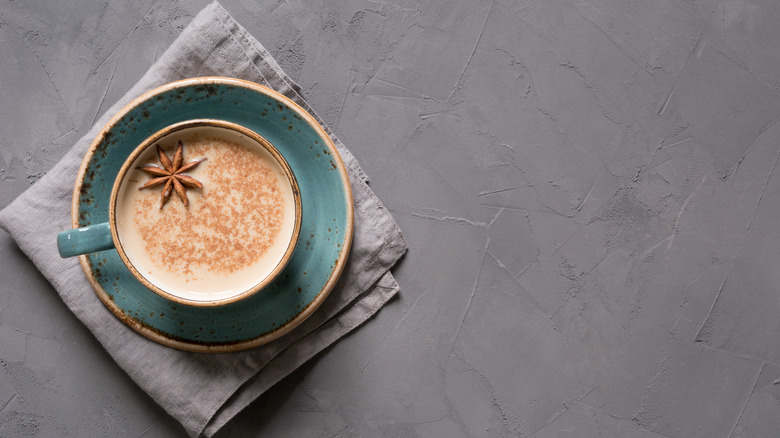The Shady Truth Of Flavored Coffee
If we're being 100% honest, we'll admit it — coffee is the elixir of life. What nectar was to the Greek gods? Yep, that's coffee to most of us.
While we love an incredible cup of gourmet coffee as much as the next person, we'll also admit that sometimes, we'll reach for that bag of French vanilla or hazelnut flavored coffee. That's because while the pure, unadulterated stuff might be great, sometimes, we just need a little variety. Variety is, after all, the spice of life.
But flavored coffee tends to be the subject of some serious scoffing by either connoisseurs or people who'd like to sound like they're connoisseurs. So, let's get one thing straight: If you love that pumpkin spice coffee that shows up on the shelves every autumn, then go ahead and love it! Drink it! In fact, grab a few extra bags to get you through the winter, because life's too short to miss out on the things you enjoy because someone else poo-poos it. But, that said, there are a few things that you might want to keep in mind as you're browsing those shelves. In fact, a few of these revelations just might change what you're buying — and ultimately what you're putting in your cup. If this makes you a little nervous, take heart. Learning the shady truth of flavored coffee might very well improve your overall coffee experience.
It can take a shocking amount of additives to get that flavor
This may be painfully obvious, but it still needs to be said. That caramel-cupcake-whipped cream-coffee isn't actually flavored with caramel cupcakes and whipped cream. So, how do they get the taste?
Artizan Coffee says that it all starts in a lab, where scientists who are really, really good at both smelling and tasting work to come up with the perfect combination of chemicals that can recreate a given flavor in coffee. Some flavors can contain up to 80 different ingredients!
Love 'em or hate 'em, flavor labs are fascinating places. WIRED went inside one at McCormick, finding that flavor researchers had thousands of different compounds and molecules that they could use to create or enhance flavors. These flavor enhancers are all over. McCormick even made one for a company that produced "a processed tomato product" and wanted more of that fresh-off-the-vine smell and taste. The solution, which was stored in a test tube, could reportedly flavor an entire swimming pool with a single drop.
Flavorings are created with the help of something called a gas chromatograph, which breaks flavors down into their base components. With this information, researchers can effectively build a flavor from scratch. The results can be so specific that they can even replicate, say, different varieties of vanilla, or herbs from different regions. That's what ends up on your coffee beans.
It's a way to disguise old beans
When it comes to determining what's "fresh," coffee beans can make things complicated. According to The Drink Trade, unroasted beans can stay fresh from anywhere between three months to a year, depending on the type of bean and how they're stored. Once they've been roasted, though, the perfect window to use them typically comes between 7 and 10 days. Here's something to keep in mind: The darker the roast, the faster it can go bad.
That's a pretty small window, so what about beans that age out before they're sold? Nick Selman, the co-founder of coffee marketplace Javaya, says that's where flavored coffee comes in (via Cooking Light). This is especially true of the flavored coffee that you might get from a certain online shopping juggernaut or from smaller discount stores.
"That coffee can be weeks, to months, to likely years old," Selman explained. Serious Eats agrees, saying that it's not all that uncommon for warehouses full of year-old beans to turn that product into flavored coffee. That way, the old beans will be hurried out the door and manufacturers can make room for new stock. Stale? You got it. But the flavoring can be used to hide a lot of faults, namely making coffee taste not-so-old. It's not that there's anything dangerous about this practice, but you may still prefer to steer clear. Selman puts it this way: "Would you buy romaine lettuce from TJ Maxx? Coffee is produce, too."
Want to raise the price of low-quality beans?
Serious Eats says there's something else going on here, something that goes back to a time when pre-ground Folgers and Maxwell House coffee was found in every home. Indeed, at that point, it's likely that many people hadn't even seen a whole coffee bean, much less the sort of high-end beans that we tend to take for granted these days.
Those were the days where coffee was more utilitarian, and it was a cup or four in the morning to simply get you going instead of something to be savored and enjoyed. Flavoring the coffee was a great way to make it taste better when companies could only source what we'd consider low-quality beans. Some companies have continued doing exactly that.
Not, however, all companies. According to what Javaya co-founder Nick Selman told Cooking Light, there are some companies out there who make good stuff, putting out flavored coffees made with high-quality, fresh beans. The way to tell what's what is fairly easy: look at the price. If it seems like you're getting a really great deal on some flavored coffee, there's probably a reason for that. You get what you pay for, after all. Or, more simply put, that flavor and cheap price are probably hiding something.
It can mask unwanted flavors and defects
Let's talk for a second about just how strong the flavoring is that's added to coffee, and what it can be used to cover up. A mysterious "Roaster X" told Serious Eats that flavoring was added by combining the beans and the flavor syrup in a plastic bag, along with a solvent to make sure everything stuck together. The bag then went through a cycle in "a cement mixer-type machine." The mixture is so strong that anyone unfortunate enough to draw the short straw to work with the syrups that shift would smell like a particular flavor for days.
That flavor can be hiding a lot. According to Java Presse, there are 11 "coffee flavor defects" that can be present in beans, particularly in the low-quality beans that some roasters use in their flavored coffees.
Those are things like the so-called potato defect, which gives coffee a slight potato flavor. It's not even clear just why it happens, but it definitely does and it's weird. There's also the possibility these low-quality beans come with the funky smell and taste of must and mold, burnt rubber, and even sharp cheese. Or it could be that they've been over-fermented. You might not be able to taste these defects with flavored coffees — that can be the point, after all, to disguise this yuckiness — but you're still drinking it.
What, exactly, is propylene glycol?
Serious Eats says it's not just flavor syrup on those coffee beans, but there's also a solvent or adhesive there, too, ensuring all the flavoring sticks. One of the most common such compounds is something called propylene glycol. It's found in plenty of other foods and drinks, pharmaceuticals, cosmetics, and chemicals like de-icing compounds and antifreeze. That's ... probably not what you want to think about when you're enjoying a nice hazelnut coffee, is it? Let's take a closer look at this eyebrow-raising ingredient.
According to Healthline, both the EU and the UDSA recognize propylene glycol as a safe food additive. That hasn't kept it from being super controversial, though, and while there aren't really restrictions on its use in the U.S., there are in Europe. There, it can only be used when it's acting as a solvent, and there are also limits on just how much can be in a given product. The World Health Organization recommends limiting daily intake to no more than 11.4 mg. Compare that to the typical American diet, which contains about 15 mg per day.
Research on propylene glycol's impact on the body is incomplete. While it hasn't been linked concretely to major problems, some researchers have drawn a line between high intake levels and the buildup of lactic acid, which can lead to kidney failure. Bottom line? Where you can skip it, you might want to do so — including in flavored coffees.
There's a chance they'll trigger an allergic reaction
This one's going to get a little complicated, so bear with us as we talk about flavored coffees and peanut allergies. No, we're not talking about that peanut butter and jelly-flavored coffee that's so gosh darn good. We're talking about the potential for peanuts in the artificial flavoring, as well as the possibility that peanut oil is used in the processing of those beans.
First, the National Peanut Board says that there's technically no such thing as a peanut oil allergy, as the allergen that triggers a reaction has been removed from some peanut oils. Highly refined peanut oil has those allergens processed out, but unrefined (also called cold-pressed, or gourmet) peanut oil still has those allergen-causing proteins present. According to Burman Coffee Traders, many small coffee roasters use peanut oil to adhere flavoring agents to the coffee beans. Whether or not that's going to cause an allergic reaction depends on the kind of oil that's used.
The flavorings themselves can be another potential worry. No Peanut Foods, a blog that investigates and categorizes foods that may or may not have been exposed to peanuts, particularly in the processing stage, reached out to a series of tea and coffee companies on this matter. One — Two Leaves and a Bud — recommended staying away from their flavored products, as they weren't 100% sure those flavorings were allergen-free.
They can ruin your brewing equipment
Oily coffee beans can cause some serious problems when it comes to coffee grinders. If you're using a grinder that's built into your espresso machine, then you're better off skipping flavored coffees altogether. Not only can the oil in flavored blends stick to and clog the grinder, but when it's part of a larger machine, you can — and will — successfully gunk up the inner workings of your machinery. The insides can become clogged and sticky, leading to irregular ground beans and buildup in hard-to-clean areas. That can all end with malfunctioning equipment.
Fortunately, you can spot oily beans before you run them through the grinder or your espresso machine. They're the ones that look shiny, and they can get that way for a few reasons. One, of course, is that they've been coated with both flavoring syrups and adhesive solvents — Burman Coffee Traders says that peanut oil is a common one. They also agree that adding flavoring is a way that some roasters hide the fact that they're using old beans, and older beans tend to be pretty oily overall, even before adding all the flavoring.
And finally, it's not just gunky beans that can get left behind on your grinder. Flavors will stick and linger, too, which can add some unwanted funk to future cups of coffee.
It's surprisingly easy to make your own flavored coffee
And now, here's the good news for anyone who loves a great flavored coffee, and it's news that manufacturers probably don't want you to hear. It's shockingly easy to make your own delicious flavored coffee at home, with none of the hassles and questionable ingredients we've been talking about. Sure, you can opt for flavoring syrups, but that's also adding a ton of sugar to your cup. Anyone who doesn't like their coffee to taste like dessert is out of luck, so let's talk about other options.
When you're using a drip maker or a Chemex, adding a bit of spice to the grounds is a brilliant, easy, and mess-free way to flavor your favorite cup of joe. We love things like a dash of ginger, star anise, clove, cinnamon, nutmeg, or even cardamom. Coffee Affection suggests a traditional Moroccan mix that includes black pepper, cinnamon, clove, cardamom, and nutmeg. One of Saudi Arabia's most popular coffees is made with ginger, cloves, cinnamon, cardamom, and saffron. Sounds pretty amazing, right?
You can also add a few drops of the vanilla extract that you keep in the baking cabinet. And if you've got a batch of cold brew in the fridge, add some citrus peels to steep in there, too. Once you start experimenting with the ingredients you have at home already, you might never reach for a bag of pre-flavored coffee ever again.
